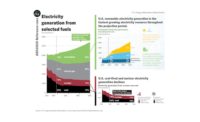Oil giant BP has said it intends to negate the carbon emissions from its operations and the fossil fuels it produces by 2050.
If successful, BP’s plan would result in reduction of the company’s emissions to net zero from a current total of 415 million tonnes of CO2 equivalent (MteCO2e) per year — and could create new avenues for work within the AEC industry.
“Plans like this typically equate to change for our industry, and change creates new opportunities for our industry to perform,” says David Helveston, president and CEO of the Pelican Chapter of the Associated Builders and Contractors in Louisiana. “How we execute construction projects has changed over the past quarter of a century, decade and even year because clients’ needs are ever changing. BP’s plans to reimage their energy systems is a prime example of those needs changing.”
It also means continuing “to innovate and upskill our workforce to advance our sector, and we will accomplish this by utilizing technology to truly cater to the changing needs of our industry’s customers,” Helveston adds.
BP’s net zero plan will cover its worldwide operations, currently equivalent to 55 MteCO2e per year, as well as carbon emissions from the oil and gas BP produces, currently at 360 MteCO2e, both on an absolute basis.
“This is what we mean by making BP net zero. It directly addresses all the carbon we get out of the ground as well as all the greenhouse gases we emit from our operations,” said BP’s new CEO Bernard Looney in the company’s announcement. “These will be absolute reductions, which is what the world needs. If this were to happen to every barrel of oil and gas produced, the emissions problem for our sector would be solved. But of course, the world is not that simple; the whole energy system has to be transformed and everyone has a contribution to make – producers and sellers of energy, policy makers and everyone who uses energy.”
In construction, the primary sources of emissions are from fuel use (e.g. vehicles and equipment) and onsite energy use (e.g. generators and electricity), notes Melinda L. Tomaino, director of environmental services for The Associated General Contractors of America.
“Contractors can employ various strategies to reduce fuel consumption from limiting the idling of equipment to right-sizing equipment for the task at hand. Some AGC members have voluntarily purchased fuel efficient vehicles for travel or light-duty tasks,” Tomaino says. “Others have tried electric vehicles or natural gas vehicles with varying success—outside of the upfront cost, the success of these ventures appears highly dependent on available infrastructure, maintenance, and the distances traveled.”
Current options for heavy-duty equipment beyond diesel remain limited today, she adds. “Strategies to reduce energy use on project sites have included solar, rechargeable batteries, and efficient lighting,” Tomaino says.
AGC has often focused on sustainability and green construction over the years, providing education on different green building rating systems including net zero energy buildings, Tomaino points out. However, “AGC focuses its efforts more on construction practices that the contractor can influence, as the owner decides what to build and whether to ‘go green’ on a specific project,” she says.
To get BP itself to net zero, the company has five aims: net zero across BP’s operations on an absolute basis by 2050 or sooner; net zero on carbon in BP’s oil and gas production on an absolute basis by 2050 or sooner; 50% cut in the carbon intensity of products BP sells by 2050 or sooner; installation of methane measurement systems at all BP’s major oil and gas processing sites by 2023, and reduction methane intensity of operations by 50%; and increased investment into non-oil and gas businesses over time.
BP also says it wants to be more active, worldwide, to advocate for policies that support net zero, including carbon pricing and plans to create a new team to help countries, cities and large companies decarbonize.
“We all want energy that is reliable and affordable, but that is no longer enough. It must also be cleaner. To deliver that, trillions of dollars will need to be invested in replumbing and rewiring the world’s energy system. It will require nothing short of reimagining energy as we know it,” Looney said. “This will certainly be a challenge, but also a tremendous opportunity. It is clear to me, and to our stakeholders, that for BP to play our part and serve our purpose, we have to change. And we want to change – this is the right thing for the world and for BP.”
While some contractors may see a net zero goal as a threat to jobs and economic growth, others are very optimistic, notes Jennifer Gordy, executive director of AGC of Southeast Texas.
“With advancements in technology comes the potential for new ways to engage and service our industrial clients. The process to eliminating or offsetting carbon emissions may not happen overnight, but the construction industry will be here to support these energy companies as they continue to innovate and move forward,” she says.





Post a comment to this article
Report Abusive Comment